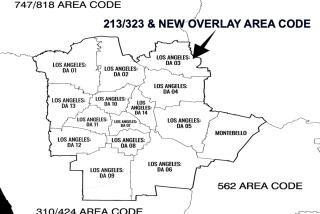New Area Codes: Just Digits Now
- Share via
Not so long ago, area codes followed a predictable formula: three numbers, with a 1 or 0 invariably in the middle. San Diego was 619, Sacramento was 916, and the White House was always in 202.
Today, seemingly any hodgepodge of numbers will do, so long as it satisfies the demand for cell phone, fax, pager and modem lines: 973, 559, 847, 352, 785, 941.
There’s something alien about the new area codes, something discordant and unkempt. Even the folks who issue the numbers allow that they can be “aesthetically displeasing,” lacking the easy symmetry of the originals.
“People have a hard time remembering odd numbers,” explains James Katz, a sociologist at Bellcore, a New Jersey-based software company that has administered area codes nationally since the 1984 breakup of AT&T.; “They don’t sound as nice.”
The original set of 144 usable codes, expected to last until the end of the century, ran out in 1994 when 610 was assigned to eastern Pennsylvania. In 1995, the Federal Communications Commission decreed that the second digit could be a number between 2 and 9, opening the way for 640 new combinations. So far, 67 of these have been issued.
When a city runs low on phone numbers, its “local number administrator,” usually an employee of the dominant phone company, contacts Bellcore for a list of available sequences, which are randomly created. “People can get seriously ticked off about the change,” said spokesman Ken Branson, clearly fed up with the whining. “From our viewpoint, area codes are not cultural icons. They’re just numbers in a bucket. When the numbers run out, you get a new bucket.”
A good deal more thought went into area codes when they debuted in 1951. The aim was to make them logical and easy to dial. In frequently called metropolitan areas, the first digit was low, to shorten the time it took a rotary dial to wheel back into place. So Los Angeles got 213 and Chicago got 312. Far-off Alaska got 907. Area codes with similar sounding numbers were placed far apart, to avoid confusion. For instance, Portland’s 503 area code was across the country from Miami’s 305.
Just why the second digit was a 1 or a 0 has several explanations. The most cited: 0 indicated a state with just one area code; a 1 in the center stood for a state with multiple area codes. Another theory: Being on opposite ends of the rotary dial, 0 and 1 reduced the chances of phoning a wrong number. A third possibility: Because phone prefixes at the time were lettered, such as BUtterfield 8 and PLaza 9, 0 and 1 distinguished long distance from local calls; they were the only numbers on a dial without corresponding letters.
From their humble origins, area codes became more than just linked to a city. They embodied it, acquiring a certain cachet. Designer Carolina Herrera tapped into the imagery when she named her new fragrance “212,” the area code of Manhattan. In Southern California, the symbolism is so powerful that tagging crews have incorporated area codes into their graffiti.
In an uncertain world, area codes represent a familiar sense of place. Time was, when you were given a phone number with a 415 area code, you knew it was San Francisco. But who knows that 678 is now Atlanta? Or that 720 is Denver? Or that 972 is Dallas?
At this, Branson breathes a heavy sigh. People who are overly attached to their area codes, he says, “are in deep personal denial. We’re out of the original numbers. They’re gone,” he says emphatically. “The new numbers serve the same purpose. They enable us to make phone calls over great distances with no hassle.”
If we’re annoyed by area code overload, some phone users 40 years ago questioned the need for them at all. Back then, long distance calls were placed by a telephone operator. The prospect of switching to an automated system so distressed a San Franciscan named Carl May that he founded the Anti-Digit Dialing League to combat what he called “creeping numberalism.”
Others worried about huge telephone bills the kids might run up behind their parents’ backs. “What happens when our extremely clever junior succeeds in calling one of the far corners of the Earth when no one is watching?” fretted Benjamin West in a letter to the editor of the New York Times. “Maybe we just plain hope it won’t work.”
But when the mayor of Englewood, N.J., made the first public direct-dial long distance call to the mayor of Anaheim on Nov. 10, 1951, there was no turning back. By the early 1960s, the entire country was hooked up.
The new numbers are expected to run out around 2025. By then, predicts Katz, advances in voice recognition technology may well make area codes obsolete. “You’ll just speak into a phone, it will recognize your voice and find the person you want,” he said. “You won’t have to go through remembering lots of numbers. It’ll be back to the easy days.”
(BEGIN TEXT OF INFOBOX / INFOGRAPHIC)
Top States by Area Code
California: 23
Texas: 15
Florida: 9
Illinois: 9
New York: 9
More to Read
Sign up for Essential California
The most important California stories and recommendations in your inbox every morning.
You may occasionally receive promotional content from the Los Angeles Times.













